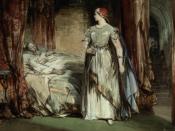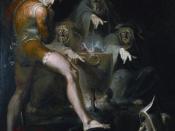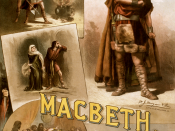Macbeth, written by William Shakespeare, is a tragedy in which Macbeth plots to kill everyone that gets in his way. In this play the symbol of blood is portrayed often and with different meanings. This symbol is developed throughout the play until it becomes the dominating theme. It's used to symbolize honor, treason, and guilt. All of these images of blood help develop the atmosphere and scene and contribute to the over all drama of the play.
The first reference of blood is one of honor, and occurs when Duncan sees the injured sergeant and says, "What bloody man is that?" This is symbolic of the brave fighter who has been injured in a valiant battle for his country. In the next passage, in which the sergeant says, " Which smok'd with bloody execution", he is referring to Macbeth's braveness in which his sword is covered in the hot blood of the enemy.
The blood at the beginning of the play earns Macbeth respect and a title.
Secondly the blood symbolizes treason. The first reference is in Act 2, Scene 1, when Macbeth sees the dagger floating in the air leading him to Duncan's room and he sees "on the blade and dudgeon gouts of blood", indicating that the knife has been viciously and violently stabbed into someone. The next reference, in Scene 2, is when Lady Macbeth smears the blood from the dagger on the faces and hands of the sleeping servants "I'll guild the faces of the grooms withal, for it must seem their guilt". This is another evil reference to blood, setting up the innocent servants of the king. Again, blood is referred to when Malcolm and Donaldbain are discussing what to do and Malcolm says, "there's daggers in men's smiles: the...



O.K.
You need to be more spcific for example ....plots to kill every one that gets in his way. Gets in the way of what? If you haven't read the book you don't know. :)
5 out of 7 people found this comment useful.